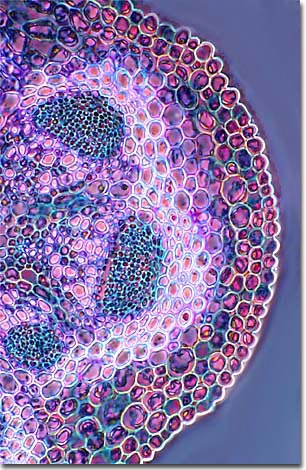Phase Contrast Image Gallery
White Pine Blister Rust
The photomicrograph below illustrates a stained thin section of pine tree stem infected with White Pine Blister Rust, a serious disease of pine trees caused by the fungus Cronartium ribicola. This fungus also is a disease of the Ribes genus (currant and gooseberry bushes), which serves as an alternate host for the fungus.

Although originally from Siberia and Asia, C. ribicola is now found in Europe and North America (both USA and Canada) where it plagues the forest industry and fruit growers alike. It was introduced along with imported trees over the past 200 years and, since 1910, has been devastating native pine ecosystems and, subsequently, the timber industry. In some regions, white pine, the most seriously affected pine species, is no longer considered a viable forest tree species.
This fungus has a complex life cycle that takes up to four years to be completed, requires two hosts, and involves five different types of spores. Both pine trees and the Ribes berry bushes have to be present in the environment for the fungus species to survive. Pine trees can only be infected by spores that develop on the berry bushes and the berry bushes can only be infected by spores that develop on the pine trees. Pycniospores and aeciospores are produced on the branches and stems of pines; urediniospores, teliospores, and basidiospores on currant and gooseberry foliage.
There is no cost-effective treatment for this fungus. Efforts were made, during the early 1900s, to interrupt the life cycle by passing legislation to eradicate currants and gooseberries, which many farms had started growing. Most of this legislation has now been repealed, however, and interest in the cultivation of these berries has increased considerably over the last few years.
Currently, researchers are trying to develop disease resistant pine trees in hopes of reintroducing white pine forests that can survive.
BACK TO THE PHASE CONTRAST GALLERY
